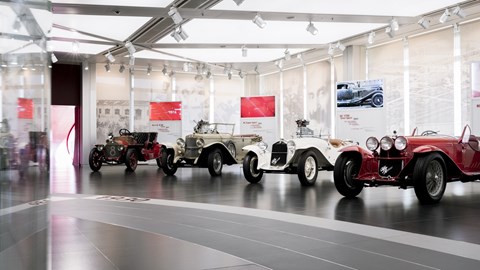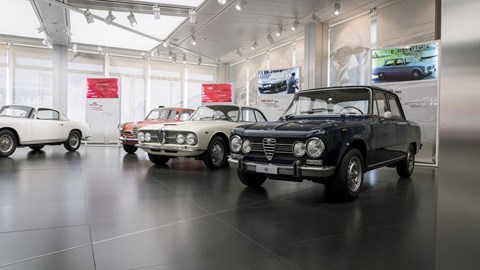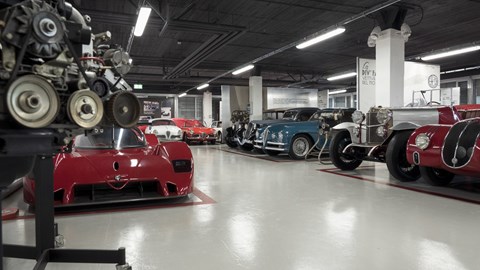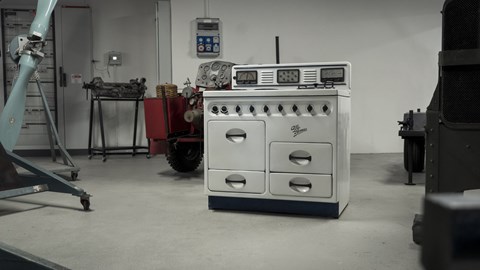► We visit Alfa’s museum in Milan
► And enjoy special access behind the scenes
► A true temple of design excellence
If there was ever a brand you’d want to have a good museum, it’d have to be Alfa Romeo, right? Though the cars may not always have been the most practical, or reliable, or rustproof, almost every one of them has been good to look at – and interesting.
Luckily, and thanks to help from the Italian government, Alfa has just that in the form of Museo Storico Alfa Romeo. Located in Milan in the former Alfa Romeo Arese factory complex, the museum is a stunning tribute to the brand – and now, punters can even head into the back rooms for a tour of never-before-seen models. Like browsing through your grandmother’s attic, there’s an amazing array of interesting stuff there.
Scooped: the new Alfa Romeo supercar due mid-decade

If you’re planning a summer jaunt to Italy, then, you may well want to make Museo Storico Alfa Romeo a stop on your tour – and for the Italian car nuts out there, it should be seen as a necessary pilgrimage.
More than anything, the museum’s also a display of how Italy sees the car and the Alfa brand. Both the building and its contents are listed, ensuring that all 286 cars inside the museum are kept in fantastic shape. Lorenzo Ardizio, the museum’s curator and our guide, describes the arrangement as the Italian government ‘starting to consider its industrial heritage as much as its artistic heritage’.
‘Art is unique, and design is the reproduction of an object,’ he explains. ‘But cars are one of the few objects that are not static.
‘Because of this, they’re important and worth preserving. Cars are classified by the Italian government in the same way as violins.’
The collection
Of the 286 cars in the museum, around a third are kept on display, with another third kept behind the scenes but uncovered and the remainder safely tucked under cover. But each one’s started up at least once a year, and a short test track allows some of them to be kept mobile too. It’s exactly how a museum should be run.
Before you get to the cars, you step through a display of aero engines and racing boats – a reminder that there’s more to the brand than just cars. Pride of place is a fully reconstructed Alfa-powered plane – the museum’s ‘lockdown project’.
But of course, it’s really about the cars. The museum’s divided into three sections – ‘velocità’ (speed) for the company’s racing heritage, ‘belleza’ (beauty) for the most aesthetically stunning, and ‘timeline’, which chronicles the most important production cars of the brand.

You start in the timeline area, laid out chronologically from the licence-built Darracq that started the company, through a spectacularly patinated RL Super Sport sourced from India and into some of the incredibly elegant creations of the 30s.
Moving on, you find a 1900 – the company’s first post-war car and a tremendously important money-maker for the brand. And the models just get more iconic as you press forward. Giulia, Alfasud, Montreal, 156, 8C… it’s like a masterclass in design brilliance, and it’s glorious.
As you head further into the depths of the museum, there’s plenty more to see. A hall of the most amazing concepts sees a reproduction of the remarkable 40/60HP Aerodinamica (a teardrop-shaped masterpiece that blends an amazing aluminium body with wooden wheels) rubbing shoulders with the Iguana, the Carabo and the 33.2 Coupe Speciale.
The next hall’s dominated by this writer’s personal favourite – the spectacular 8C 2900B Lungo. Its Touring body is resplendent in baby blue, with a straight-eight only slightly detuned from the racing models sitting underneath a mile-long bonnet. It’s the ultimate in selfish excess, one of only ten built, and a real highlight.

The view turns red as you head into the lower decks, packed with everything from F1 racers to Mille Miglia to Touring car entrants. It’s here you’ll also find the museum’s most valuable car, another 8C – this time a 2900B Speciale Tipo Le Mans.
A few further displays – including a particularly nice array of Italian police Alfas – concludes the main part of the museum. On its own, a necessary pilgrimage for any Alfisti. But the real fun comes once you step behind the scenes…
Backstage
The remainder of the museum’s stock sits on several floors of the building unused by the main displays. Previously unseen, it opened up in 2020 though, due to some pesky virus, it’s only really now that people are benefitting from being able to visit.
You don’t even need to be an Alfa nerd to appreciate what’s here. Nothing’s curated, nothing’s displayed – instead, it’s just amazing sight after amazing sight rubbing shoulders with each other.

Here’s a rack of styling models. Here’s a prototype Alfa wankel engine. Here’s a spark plug tester. Here’s a stray concept car. This writer could have spent a week there and not felt bored.
Highlights? Well, some of Alfa’s less sporting concepts are hidden here – a New York taxi, for example, or a distinctly boxy 4×4 that’s probably best kept apart from the modern Stelvio.
There’s also an array of Alfa’s non-car products, produced during and immediately after WWII. The most charming? An Alfa Romeo electric cooker, which comes complete with chassis plate and the Alfa script embossed into the hotplates.

Every corner hides something new and exciting, whether it’s a 164 bodied as an estate or a test mule with ‘Rover’ brazenly pasted across the front to hide its true origins.
Backstage tours are conducted in small groups and are guided – a necessity, as you’ll find no info cards for any exhibit. Luckily the sort of people who work at the Alfa Romeo museum are exactly the sort of people you want guiding you for a tour. You’ll need to email collezione@museoalfaromeo.com to book yours.
It’s worth every penny of the eight Euros it’ll set you back. While a good car museum is a treat regardless of brand, this sort of backstage access is nothing short of fascinating. Museo Storico Alfa Romeo, then, comes very highly recommended by us.
All our Alfa Romeo reviews